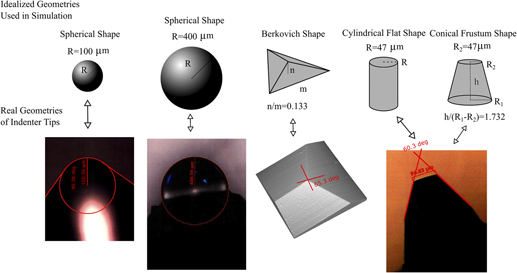Crossref Citations
This article has been cited by the following publications. This list is generated based on data provided by
Crossref.
Gao, Chenghui
and
Liu, Ming
2017.
Power law creep of polycarbonate by Berkovich nanoindentation.
Materials Research Express,
Vol. 4,
Issue. 10,
p.
105302.
Qian, Zhiyuan
Risan, Jared
Stadnick, Benjamin
and
McKenna, Gregory B.
2018.
Apparent depth‐dependent modulus and hardness of polymers by nanoindentation: Investigation of surface detection error and pressure effects.
Journal of Polymer Science Part B: Polymer Physics,
Vol. 56,
Issue. 5,
p.
414.
Gao, Chenghui
Yao, Ligang
and
Liu, Ming
2018.
Berkovich nanoindentation of borosilicate K9 glass.
Optical Engineering,
Vol. 57,
Issue. 03,
p.
1.
de Sá, Marcelo Jorge Cavalcanti
de Lima, Gabriel Goetten
de Sousa Segundo, Francisco Alipio
and
Nugent, Michael J. D.
2018.
Cellulose-Based Superabsorbent Hydrogels.
p.
1.
Maji, Debashis
and
Das, Soumen
2018.
Atomic force microscopy and nanoindentation investigation of polydimethylsiloxane elastomeric substrate compliancy for various sputtered thin film morphologies.
Journal of Biomedical Materials Research Part A,
Vol. 106,
Issue. 3,
p.
725.
Yang, Weixu
Wang, Xiaoli
Li, Hanqing
Wu, Jun
and
Hu, Yanqiang
2018.
Comprehensive contact analysis for vertical-contact-mode triboelectric nanogenerators with micro-/nano-textured surfaces.
Nano Energy,
Vol. 51,
Issue. ,
p.
241.
Yang, Yang
Xiao, Xiaoxiao
Peng, Yan
Yang, Chen
Wu, Siqi
Liu, Yuanyuan
Yue, Tao
Pu, Huayan
Liu, Na
and
Jiang, Haowen
2019.
The comparison between force volume and peakforce quantitative nanomechanical mode of atomic force microscope in detecting cell's mechanical properties.
Microscopy Research and Technique,
de Sá, Marcelo Jorge Cavalcanti
de Lima, Gabriel Goetten
de Sousa Segundo, Francisco Alipio
and
Nugent, Michael J. D.
2019.
Cellulose-Based Superabsorbent Hydrogels.
p.
789.
Rubiano, Andrés
Galitz, Carly
and
Simmons, Chelsey S.
2019.
Mechanical Characterization by Mesoscale Indentation: Advantages and Pitfalls for Tissue and Scaffolds.
Tissue Engineering Part C: Methods,
Vol. 25,
Issue. 10,
p.
619.
Chen, Shikun
Wu, Chenglin
and
Yan, Dongming
2019.
Binder-scale creep behavior of metakaolin-based geopolymer.
Cement and Concrete Research,
Vol. 124,
Issue. ,
p.
105810.
Ovchinnikov, I. S.
Vishnevskiy, A. S.
Seregin, D. S.
Rezvanov, A. A.
Schneider, D.
Sigov, A. S.
Vorotilov, K. A.
and
Baklanov, M. R.
2020.
Evaluation of Mechanical Properties of Porous OSG Films by PFQNM AFM and Benchmarking with Traditional Instrumentation.
Langmuir,
Vol. 36,
Issue. 32,
p.
9377.
Wang, Yuemin
Shang, Lei
Zhang, Panpan
Yan, Xiangqiao
Zhang, Ke
Dou, Shuliang
Zhao, Jiupeng
and
Li, Yao
2020.
Measurement of viscoelastic properties for polymers by nanoindentation.
Polymer Testing,
Vol. 83,
Issue. ,
p.
106353.
Orikasa, Kazue
Bacca, Nicole
and
Agarwal, Arvind
2021.
Meso/macro-scale ultra-soft materials’ mechanical property evaluation device and testbed.
Review of Scientific Instruments,
Vol. 92,
Issue. 7,
Benalcázar Jalkh, E.B.
Coelho, P.G.
Witek, L.
Bergamo, E.T.P.
Lopes, A.C.O.
Monteiro, K.N.
Cesar, P.F.
Genova, L.A.
Lisboa-Filho, P.N.
Abreu, J.L.B.
Campos, T.M.B.
Canteenwala, A.
and
Bonfante, E.A.
2021.
Nanoscale physico-mechanical properties of an aging resistant ZTA composite.
Journal of the Mechanical Behavior of Biomedical Materials,
Vol. 123,
Issue. ,
p.
104690.
Arora, Gaurav
and
Pathak, Himanshu
2021.
Nanoindentation characterization of polymer nanocomposites for elastic and viscoelastic properties: Experimental and mathematical approach.
Composites Part C: Open Access,
Vol. 4,
Issue. ,
p.
100103.
Maithani, Yogita
Mehta, Bodh Raj
and
Singh, Jitendra Pratap
2021.
Investigating the effect of silver nanorods embedded in polydimethylsiloxane matrix using nanoindentation and its use for flexible electronics.
Journal of Applied Polymer Science,
Vol. 138,
Issue. 14,
Yang, Weixu
Wang, Xiaoli
Chen, Ping
Hu, Yanqiang
Li, Lizhou
and
Sun, Zhen
2021.
On the controlled adhesive contact and electrical performance of vertical contact-separation mode triboelectric nanogenerators with micro-grooved surfaces.
Nano Energy,
Vol. 85,
Issue. ,
p.
106037.
Zhang, Zhenxue
Bellisario, Denise
Quadrini, Fabrizio
Jestin, Simon
Ravanelli, Francesca
Castello, Mauro
Li, Xiaoying
and
Dong, Hanshan
2022.
Nanoindentation of Multifunctional Smart Composites.
Polymers,
Vol. 14,
Issue. 14,
p.
2945.
Symons, Henry E.
Galanti, Agostino
Surmon, Joseph C.
Trask, Richard S.
Rochat, Sebastien
and
Gobbo, Pierangelo
2022.
Automated analysis of soft material microindentation.
Soft Matter,
Vol. 18,
Issue. 43,
p.
8302.
Arevalo, Sofia E.
Ebenstein, Donna M.
and
Pruitt, Lisa A.
2022.
A methodological framework for nanomechanical characterization of soft biomaterials and polymers.
Journal of the Mechanical Behavior of Biomedical Materials,
Vol. 134,
Issue. ,
p.
105384.
